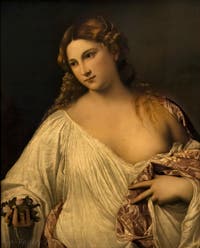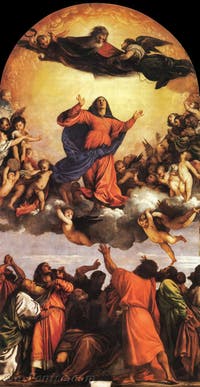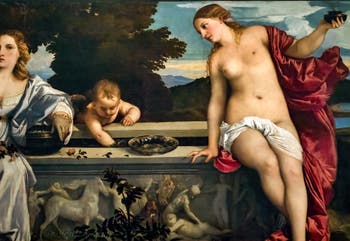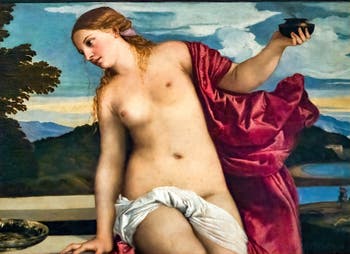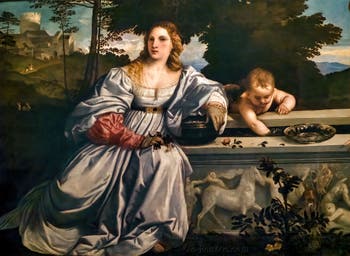Art Painters | Music | Literature | Video | Pictures
Painters Tintoretto | Titian | Canaletto | Fortuny | Albrecht Dürer |
Titian Tiziano Vecellio (or Tiziano Vecelli) - 1488-1576

Titian, Venus - Ca' d'Oro Titian, whose real name was Tiziano Vecelli, illuminated Italian Renaissance art. A painter of genius who described his paintings as “poems”. And what poems, what an artist! Deep portraits, moving Venuses and deified Virgins, light and colour, preferably red for this artist who represented the flesh as well as the soul.
Titian: The Painter of Universal Life
Elie Faure said of him:“Titian painted universal life. When it comes to collecting its voices, he seems indifferent.
All enter him with equal rights, the bodies of children, the flesh of women, virile figures, sumptuous or sober costumes, architectures, the earth with its trees and flowers, the sea, the sky and all the wandering atoms that make the sea and sky never cease to combine their forces.
Flora Creative enthusiasm lifts him so high that his serenity does not abandon him when all this world assimilated and recreated in a new order emerges from him, in ever longer and wider waves.
This is organised into symphonies where everything human resounds in uninterrupted echoes in everything that lives only by an instinctive and obscure life, where everything material penetrates human forms with a confused eternity. [...]
All of Titian's painting is here, after it all the painting of Venice, after the painting of Venice all the living paintings that will see colours penetrate, reflections play on surfaces, transparent shadows become coloured, a tone never repeats itself, The luminous life of the world will make a spontaneous symphony where not a palpitation will be born from its substance without being able to find its cause and seek its effect in all its extent. ”
Elie Faure
Campo del Tiziano

Flora Tiziano Vecelli known as Titian was born around 1488 in Pieve di Cadore in the Friuli and died in Venice on August 28, 1576.
in Venice, he lived at Campo del Tiziano, numbers 5181/5182.
The altarpiece of St. Mark in Santa Maria della Salute
Titian painted the altarpiece of “St. Mark surrounded by St. Cosimo and St. Damian, St. Roch and St. Sebastian” in 1510, which is now in the church of Santa Maria della Salute.This commission followed the great plague epidemic in order to celebrate the help provided by both religious institutions and the Venetian government during this difficult period in Venice's history. It is one of his earliest altarpieces.
Student of Giovanni and Gentile Bellini but also of Giorgione
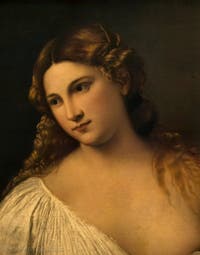
Flora Titian himself learned and enriched his palette from one of the greatest Venetian painters of the time: He trained in the studios of Giovanni and Gentile Bellini in his youth and then with Giorgione, with whom, as a... gifted pupil, he would complete the composition for the fresco of the “Miracle of the Newborn” at the Scuola di Sant'Antonio in Padua in 1511.
But compared to Giorgione, Titian is the master of light, of chromatic clarity, Titian banishes the shadow so present in Giorgione's paintings. No more shaded volumes.
Titian paid no taxes!
In 1513, Titian was commissioned by the Serenissima to paint the “Battle of Spoleto” following the fire that had destroyed the canvas commemorating this high war feat, painted in the 14th century by Guariento.25 years later, in 1538, the canvas was delivered. Was Titian so slow?
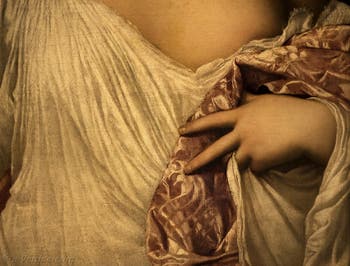
Flora No, Titian was above all clever, because in exchange for producing this painting, the Serenissima had undertaken to confer on Titian the office of “Sensaria” at the Fondaco dei Tedeschi.
This office was a mediator's office that guaranteed income to its beneficiary.
The office essentially consisted of the obligation to supervise the decoration of the Doge's Palace but also to paint the official portraits as well as the votive painting of every new doge.
But as the said office was still held by the already elderly Giovanni Bellini at the time Titian began his painting... so he began by taking his time to complete his canvas and ensure he was rewarded as promised!
To fully understand Titian's mischievous side, you need to know that he even managed to get a permanent tax exemption... later on.
It's enough to make any of us dream!
But that doesn't explain everything, as Bellini died in 1516 and Titian became the official painter of the Republic. The real reason lies elsewhere, Titian was in fact rather prolific and painted several works at once: portraits, official and private, profane Venuses and sacred Virgins...
A Bon Vivant
It's easy to imagine Titian as a master looking down on humanity from the pedestal his contemporaries had raised him to, but he was also a man who loved life and... good food.The proof is in this anecdote recounted by l'Arétin in one of his famous letters:
“Here's one of your valets bringing me thrushes. No sooner had I tasted them than I began to sing the “inter aves turdus”.
The effect was that our friend Titian, seeing them on the spit and sniffing them, took one look at the snowflakes that were falling without any moderation while the table was being set and planted a bunch of gentlemen there who had invited him to dinner.
Here we all are, singing in chorus the praises of these long-beaked birds boiled with lichettes of dried meat, two sprigs of laurel and a fair amount of pepper. We ate them for the love of you and for our pleasure.”
The Aretin
Titian - Tiziano Veccellio “The Assumption of the Virgin”
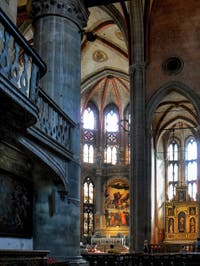
Assumption of the Virgin Mary One of Titian's most magnificent and best-known works is “The Assumption of the Virgin”, which inspired Richard Wagner to create his "Master Singers", so overwhelmed was he by the sight of the painting.
It was on 19 May 1518 that the altarpiece of the Assumption of the Virgin was installed in the Church of the Frari.
This painting is a veritable religious revolution: The Assumption is a painting bursting with colour and life, far removed from the clichés hitherto respected in religious painting: forgotten are the references to death and all the tombs and other lamentations of all kinds!
It is a joyful Virgin, surrounded by amazed angels and before equally moved apostles that the Virgin ascends to God as Queen of Heaven.
Théophile Gautier: A Virgin lighter than the lightest ether...
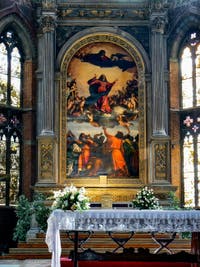
Assumption of the Virgin Mary Théophile Gautier totally fell in love with it, like so many others.
“The Assunta is one of Titian's greatest machines where he rose to the greatest height: the composition is balanced and distributed with infinite art.
The upper section, which is arched, represents paradise, glory, to use the ascetic language of the Spanish; Rings of angels, drowned and lost in a flood of light at incalculable depths, stars twinkling on the flame, brighter sparkles of the eternal day, form the halo of the Father who arrives from the depths of infinity, with the movement of a soaring eagle, accompanied by an archangel and a seraph whose hands support the crown and the nimbus. [...]
Assumption of the Virgin Mary Boundless power and imperishable youth radiate from this white-bearded face, which need only shake to make the snow of eternity fall from it: not since Phidias's Olympian Jupiter has the master of heaven been portrayed with more dignity.
The centre of the painting is occupied by the Virgin Mary, who is lifted up, or rather surrounded, by a garland of angels and blessed souls, for she needs no helpers to ascend to heaven; she is lifted up by the gush of her robust faith, by the purity of her soul, lighter than the most luminous ether.
There is truly an unheard-of force of ascent in this figure, and to achieve this effect, Titian did not resort to spindly forms, streamlined draperies or transparent colours.
His Madonna is a very real woman, very alive, very real, with a solid beauty like the Venus de Milo or the Reclining Woman in the Florence Tribune.
An ample, full drapery flutters around her with numerous folds; her broad sides could have contained a God. […]
Titian, Assumption of the Virgin And yet, nothing is more heavenly beautiful than this tall, strong figure in her pink tunic and azure mantle; despite the powerful voluptuousness of the body, the eyes sparkle with the purest virginity.
At the bottom of the painting, the apostles are grouped in various attitudes of delight and surprise, skilfully contrasted.
Two or three little angels, linking them to the middle zone of the composition, seem to be explaining the miracle that is taking place. The heads of the apostles, of various ages and characters, are painted with surprising life force and reality.
The draperies have that width and abundant flow that characterise Titian as both the richest and simplest painter. […]
Thanks to a powdery shroud that covered her for so long, the Assunta shines with a youthful brilliance, the centuries have not sunk in for her, and we enjoy that supreme pleasure of seeing a painting by Titian as it emerged from his palette.”
Théophile Gautier
Félix Mendelssohn Bartholdy: "I will go and see this painting again every day..."

Assumption of the Virgin Musician Felix Mendelssohn Bartholdy also admired this painting by Titian:
“The Assumption of the Virgin is the most divine work that human hands have ever produced.
I couldn't help expressing my enthusiasm to the local lackey, and in bad Italian.
If I have to talk about Titian, I can only do so in a tone full of respect.
That he enjoyed life in all its beauty and fullness, the paintings in Paris would be enough to convince us.
He plumbed both the depths of human distress and the joys of Heaven.
You have to see his Entombment of the Dead. You have to see his Entombment and Assumption.
You have to see how Mary seems to float in the clouds, how the air she breathes seems real, her awe, her fear. You must see how Mary seems to float in the clouds, how the air she breathes seems real, her fear, her devotion, in short thousands of mixed feelings.
Words, in comparison, are just poor commonplaces.
On the right of the painting, the heads of the three angels are the height of beauty: pure, serene, seraphic beauty.
But I'll stop here, otherwise I'll get lyrical, if I haven't already, and that's hardly appropriate. I'll certainly go and see this painting again every day.”
Felix Mendelssohn Bartholdy
Charles Dickens, Gustave Flaubert, Andrew Buisine, Andrew Malraux...
Charles Dickens was also in awe of the painting:

Titian, Assumption of the Virgin
“No praise manages to say half of the beautiful and surprising reality. This is the essence of perfection.”
Charles Dickens
Gustave Flaubert:
“The few hours I spent there were in a gondola, in Titian and Veronese.
In painting I know of nothing that is above the Assumption of the former.
If I stayed here for a while I'd be afraid of falling in love with his Virgin ”
Alain Buisine, in his very fine “A Loving and Learned Dictionary of the Colours of Venice”
“This fabulous upward movement of the entire composition, with the apostles raising their arms to heaven.
This incredible, sensual and immodest ecstasy of the Virgin, her eyes capsized, which can only be compared to Bernini's The Ecstasy of Saint Teresa, in Santa Maria della Vittoria, Rome.
These subtle variations in the range of reds, from vermilion red to crimson madder lacquer (modern names, of course), are present in all the works. modern names, of course), present at every level of the representation, God the Father's dark red cloak, the Virgin's immense robe of brilliant red, the red tunics of several of the apostles.”
Alain Buisine
Andre Malraux himself insists on the importance of this work by Titian:

Titian, Assumption of the Virgin
“In the work of this first Titian, colour plays the same role as in the work of Giorgione.
But before the Bacchanalia, twenty years before the Venus of the Pardo, Titian painted the Assumption.
The Frari make no mistake in contrasting this with Raphael's Transfiguration.
And the enthusiasm of the people of Venice in front of the flamboyance of this red Madonna was not directed at a prodigious trompe-l'oeil.
How could it not make us think of the excitement of Florence and Siena before the first the first Tuscan Virgins?
Although Titian's Madonnas do not belong to the world of God as they do, nor as those in cathedrals, they do not belong to the world of earth.
This age-old language of colour, attuned in Flanders to the shadow of Van Eyck, had reappeared even in the Portinari triptych; muted in Italy by the shadow of Leonardo and by sfumato, it suddenly rediscovers its iconic lyricism - in a representation that Byzantium would have judged sacrilegious.”
Andre Malraux - the Unreal
Titian's Venuses: Painting with... bare hands
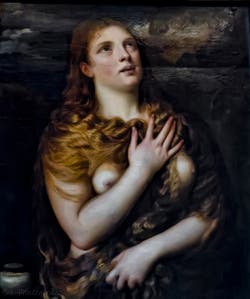
Saint Mary Magdalene Penitent But Titian respected love and the beauty of women just as much, and these secular works, including “Venus in the Mirror”, show another side of Titian's talent, one of a kind. of Titian's talent, a painter who knew how to render the naked skin of women as well as the wiser drapery of saints.
The Marquis de Sade and Titian's Venus
The Marquis de Sade made no mistake about it:
“Titian's Venus is a beautiful blonde, the most beautiful eyes one can see, the features a little too pronounced for a blonde, whose charms it seems the hand of nature must soften as well as her character.
We see her on a white mattress, scattering flowers with one hand, hiding her pretty little mound with the other.”
Marquis de Sade
Paul Valéry and Andrew Malraux: Tremors and Sensuality

Titian Venus in the Mirror Paul Valéry to complete this sensuality of Titian's canvases with these words:
“One feels clearly that for Titian, when he arranges a Venus of the purest flesh, softly assembled on purple in the fullness of her perfection as goddess and painted thing, to paint was to caress, to join two voluptuousnesses in a sublime act, where the possession of oneself and one's means, the possession of the beautiful by all the senses merge.”
Paul Valéry
Andrew Malraux completes:
“The amber quiver that dispenses to its Venuses the gift of happiness”
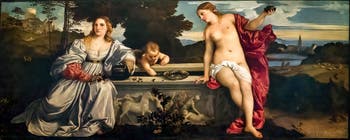
Titian, Sacred Love and Profane Love In short, a pictorial foreshortening of official Venice and... unofficial Venice, the Venice of multiple religious institutions rubbing shoulders with profane love and the famous courtesans of Venice.
Titian shows this Venetian dichotomy admirably well in his superb painting “Sacred Love and Profane Love” which you can admire in the Borghese Gallery in Rome.
The poet Marc Alyn
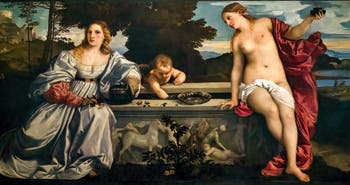
Titian Sacred Love Profane Love Marc Alyn in his beautiful book “The Pedestrian of Venice”:
“Titian is the painter of pleasure par excellence.
Nudity, with him, blazes with a clarity that seems to emerge from the encounter between eye and skin, like a match rubbed on a scraper.
Titian, Sacred Love In Diana and Actaeon or Diana and Callisto, the garlands of flesh offered up are multiplied, sighing; under the mythological pretext, we can easily find the unshy beauties wrestled by Titian in his friend the Aretinus.
More representative, perhaps, of a fundamentally Venetian eroticism, Venus and Love with an Organist heralds the distancing that was to constitute the essence of pleasure in a future society increasingly based on images.
Titian, Sacred Love A shapely female figure surrenders dreamily to the caresses of a Cupid more inclined to the thigh than the wing, while the organ player turns round sponging the spectacle with his eyelids to the last drop.
The stage overlooks the countryside, as if the painted surface were designed as a balcony overlooking a vast natural site.
The blind Eros here becomes Eros the voyeur.
Titian, profane love It is through the eye that Venice enjoys in the maze of its colours: fulgurances, transcendent lust, and so many suns in rut beneath its heavy eyelids.
She seduces and captivates the eye, on the fringes of the imagination and a physical exploration identical to death.
Those who penetrate it melt into the translucent freshness of a fruit.
And music slyly accompanies every caress; the organist is the creator of orgasms, the instrument of Revelation.
Only in Venice can we aspire to become God.”
Painters Tintoretto | Titian | Canaletto | Fortuny | Albrecht Dürer |
Art Painters | Music | Literature | Video | Pictures
Back to Top of Page


